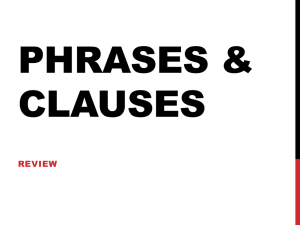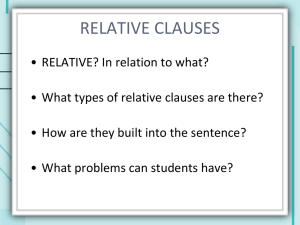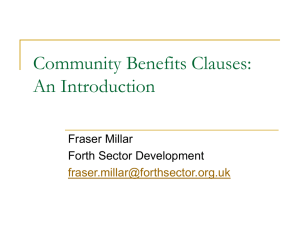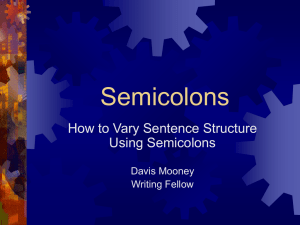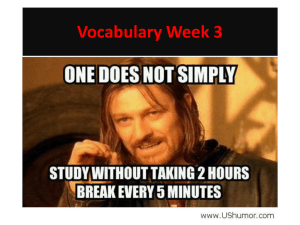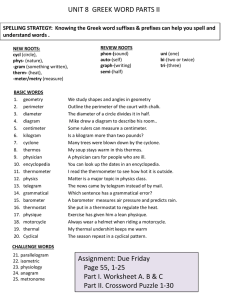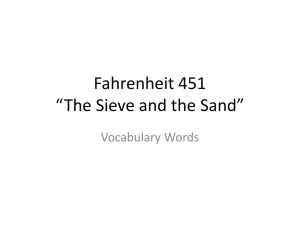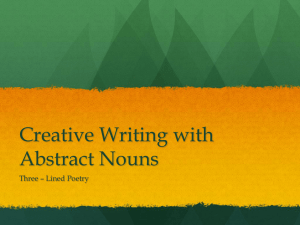Academic writing
advertisement
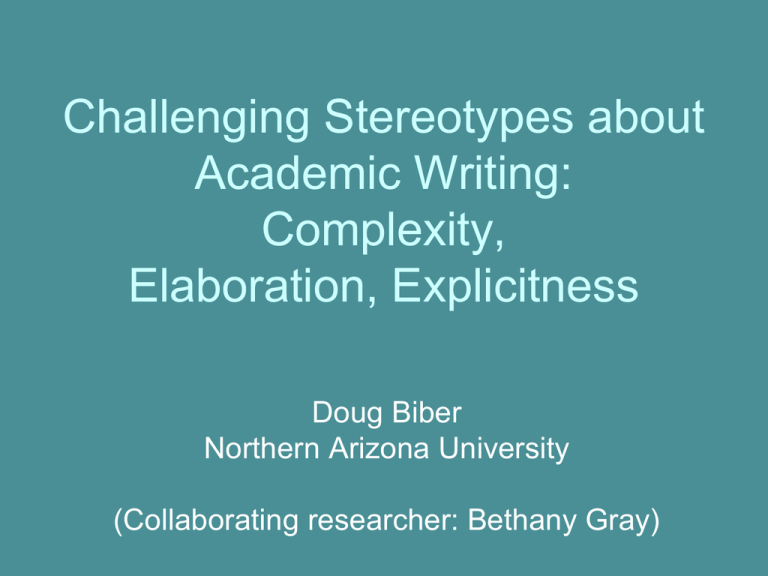
Challenging Stereotypes about Academic Writing: Complexity, Elaboration, Explicitness Doug Biber Northern Arizona University (Collaborating researcher: Bethany Gray) Background: Generally accepted claims about writing in comparison/contrast to speech • • • • Complex Elaborated Explicit in meaning E.g., Hughes (1996.32-34), comparing writing to speech: – longer and more complex clauses – full phrases and clauses with little abbreviation or ellipsis – explicit and varied marking of clause relations – explicit presentation of ideas – explicit indication of text organization Elaboration and/or explicitness as a characteristic of academic research writing Li & Ge (2009): “a more elaborate presentation of the data-analysis procedures may serve to strengthen the […] accuracy (e.g. clearer, precise) […] of the Results section […] “ (p. 98) Hyland (2008: 11, 16): “Here then we see the emphasis of the soft knowledge fields on […] identifying and elaborating relationships in argument” “This reflects the more discursive and evaluative patterns of argument in the soft knowledge fields, where persuasion is more explicitly interpretative […] The presentation of research is therefore altogether more discursively elaborate, […]” Hyland & Tse (2005): […] in academic writing […] elaborated structures are generally preferred as they facilitate the readers’ understanding of the text. (p. 127) Elaboration and/or explicitness as a characteristic of student academic writing Wright (2008): “Students [writing chemistry lab reports] engage in elaborated discourse with a high degree of specificity […] Once they have focused on salient data and evidence, elaborated forms of discourse arrange information into more complex and explicit representations reflective of canonical scientific ideas.” (p. 292) Keen (2004): “Myhill (1999) identifies elaboration and use of subordination as features which tend to characterise high quality Grade A writing […]” (p. 95) “The redrafting process facilitates “ progressively more extended clause planning and greater elaboration.” (p. 96) Major goals of the talk Challenge all three generalizations about the language of academic prose: 1. Complex: Not according to traditional measures. • There is actually more clausal embedding in conversation 2. Elaborated: actually more 'compressed' than 'elaborated'. 3. Explicit: academic style has evolved to become increasingly less explicit in the expression of grammatical and textual relations Is Biber saying that academic writing is not complex? Yes and No. Yes: The grammatical characteristics usually used to measure complexity are not typical of academic writing. Conversation is actually more ‘complex’ if we consider those features But no, academic discourse is complex in its use of other grammatical features Why does this matter for language pedagogy? • Teaching EAP writing: Many books emphasize grammatical features that are not actually characteristic of academic writing • Testing (and researching) writing development: usually emphasizes grammatical measures that are not actually relevant for academic writing ‘Complexity’ and 'Elaboration‘ (1) • Elaboration, clausal subordination, and grammatical complexity are usually linked in linguistic theory. • A ‘simple’ clause has only a subject, verb, and object or complement. A ‘simple’ noun phrase has a determiner and head noun. • ‘Elaboration’ = structural additions, resulting in ‘complex’ grammar ‘Complexity’ and 'Elaboration‘ (2) • Descriptive linguists: dependent clauses are the most important measure of grammatical complexity (often contrasted with ‘simple’ clauses; see e.g., Huddleston 1984: 378; Willis 2003: 192; Purpura 2004: 91; Carter & McCarthy 2006: 489). • Researchers on writing development: dependent clause measures (see Brown et al. 2005; Ellis & Yuan, 2004; Larsen-Freeman, 2006; Nelson & Van Meter, 2007; Li, 2000; Norrby & Håkansson, 2007) • Wolfe-Quintero et al. (1998: 118-9): measures based on dependent clauses are the “best […] complexity measures so far” What does corpus research tell us? Major corpora for the study • Conversation – Synchronic: Longman Network; 713 texts; 4,175,000 words – Diachronic: Drama 1700-1990: ARCHER, 75 texts; c. 75,000 words • Science/medical academic research articles – Synchronic: 20th c. science research articles, 1965, 1985, 2005: 155 texts, 655,000 words – Diachronic: • ARCHER, 1700-1990: 160 texts; c. 160,000 words • Corpus of English Texts on Astronomy (A Coruña), 1700-1900: 42 texts; c. 400,000 words 'Elaboration' features • Contractions and 'incomplete sentences' are common in conversation; rare in academic writing: A: Of course he gets mad cos he can't smoke cos we always take non-smoking. B: Oh well. • But structural compression is much more prevalent than structural elaboration in academic writing – Phrasal embedding is much more common than clausal embedding ‘Elaboration' features: Dependent clauses • Overall, dependent clauses are actually more common in speech than in academic writing – especially finite dependent clauses functioning as clausal constituents – Adverbial clauses are more common in speech • So she can blame someone else if it doesn't work. – Complement clauses are more common in speech • I don’t know how they do it – Post-nominal clauses are more common in academic writing • the quantity of waste that falls into this category … • The results shown in Tables IV and V add to the picture … Figure 1. Com m on finite clause types functioning as clausal constituents 12 10 Conversation Rate per 1,000 words 8 6 Academic Writing 4 2 0 Finite adverbial clauses V+THAT V+WH Examples from conversation • I just don’t know [if that’s [what he wants] ] • But I don't think [we would want [to have it [sound like [it's coming from us] ] ] ] Conversation Gayle: And Dorothy said Bob's getting terrible with, with the smoking. Uh, he's really getting defiant about it because there are so many restaurants where you can't smoke and he just gets really mad and won't go to them. […] Peter: Well they, they had a party. I forget what it was. They had it at a friend's house. I can't remember why it wasn't at their house any way. And they had bought a bottle of Bailey's because they knew I liked Bailey's. […] Gayle: I can't remember who it was. One of us kids. […] Peter: Oh. I'll tell you I think the biggest change in me is since I had my heart surgery. Gayle: Really? Yeah I guess my, I mean I know my surgery was a good thing but Peter: <?> It makes you think. You realize it can happen to you. ‘Compression' features: Dependent phrases Embedded phrases (non-clausal) are extremely common in academic writing For example: Each new level [of system differentiation] opens up space [for further increases [in complexity] ]. – Attributive adjectives • new level, further increases – Nouns as pre-modifiers of a head noun • system differentiation – Post-nominal prepositional phrases • level [of system differentiation] • space [for further increases [in complexity] Figure 2. Com m on dependent phrasal types functioning as constituents in a noun phrase 70 60 Conversation Rate per 1,000 words 50 40 Academic Writing 30 20 10 0 Attributive adjectives in NPs Premodifying nouns in NPs Postmodifying prepositional phrases in NPs Academic writing: Noun phrases with non-clausal modifiers • This patterning [of behavior] [by households] [on other households] takes time. This may indeed be part [of the reason [for the statistical link [between schizophrenia and membership [in the lower socioeconomic classes] ] ] ]. • In conclusion, it is suggested that the interspike intervals [in a burst] and the silent intervals [between bursts] are two important determinants [of the effectiveness [of the burst pattern] [in promoting neuropeptide release] ]. Differing complexities in speech versus academic writing Favored in conversation ------- Favored in academic writing Parameter A: Structural type finite dependent clauses vs. dependent phrases (non-clausal) Parameter B: Syntactic function structures that are vs. structures that are constituents in clauses constituents in noun phrases Intermediate complexity features • E.g., nonfinite clauses as clause constituents; finite clauses as noun phrase constituents • Syntactic function is more important than structural type: – Clause constituents are preferred in conversation, even when they are nonfinite dependent clauses and non-clausal phrases – Noun phrase constituents are preferred in writing V V +T O er bi Pal s* ad ve rb ia ls * +I N TH G A TN co ou m n+ p TO -c N om + P p re p + TH IN A G T re N la on t iv W f in es H ite re la re t iv la tiv es e cl au se s * per 100 w ords n+ P er bad v N ou A dv Rate per 1,000 words Figure 3. Dependent structures that m ix the tw o param eters 10 9 8 Conversation 7 6 5 4 Academ ic Writing 3 2 1 0 Dimension 1 in Multi-Dimensional studies of English • 1988 general spoken and written registers • 2006 university spoken and written registers Study Corpus Linguistic features on Dimension 1 Biber 1988 spoken and written registers 1st and 2nd person pronouns, other pro. present tense, mental verbs, modals, emphatics, hedges, verb+that-complement clauses (usually with 0 complementizer), causative adverbial clauses, WH-clauses versus nouns, prepositions, attributive adjectives, long words, type/token ratio Biber 2006 university spoken and written registers contractions, demonstrative pronouns, it, 1st person pronouns, present tense, time advs, that-omission, WHquestions, etc., verb+that-complement clauses (usually with 0 complementizer), WH-clauses, adverbial clauses: causative, conditional, other versus nominalizations, long words, nouns, prepositions, abstract nouns, attributive adjectives, passives, stance noun + toclause, etc. General English Dimension 1 (1988 study) INVOLVED | TELEPHONE CONVERSATIONS 35 + FACE-TO-FACE CONVERSATIONS //////// 20 + Personal letters, SPONTANEOUS SPEECHES //////// | PREPARED SPEECHES, Romance fiction 0 + | General fiction, Professional letters | BROADCASTS -5 + | Science fiction | Humor -10 + Popular lore; Editorials; Hobbies | Biographies | Press reviews -15 + Academic prose; Press reportage | | Official documents -20 + INFORMATIONAL Measuring complexity for writing development: t-unit length and clauses per t-unit • Conversation eg: Well, since he got so upset, I just didn’t think we would want to wait for Tina to come back. – t-unit length: 20 • Academic writing eg: This may be part of the reason for the statistical link between schizophrenia and membership in the lower socioeconomic classes. – t-unit length: 20 Measuring complexity for writing development: t-unit length and clauses per t-unit [cont.] Conversation: Well [since he got so upset], I just didn’t think [we would want [to wait for [Tina to come back] ] ] main verb: think number of dependent clauses per t-unit: 4 Measuring complexity for writing development: T-unit length and clauses per t-unit [cont.] Academic writing: This may be part of the reason for the statistical link between schizophrenia and membership in the lower socioeconomic classes. main verb: be number of dependent clauses per t-unit: 0 Diachronic change towards compressed (less elaborated) phrasal structures in the noun phrase • Increasingly dense use of non-clausal modification • Academic writing has been the most innovative / receptive to change Figure 3: Historical change in the use of nouns as nom inal pre-m odifers in academ ic prose 90 80 70 Rate per 1,000 words 60 50 40 30 20 10 0 1725 1775 1825 1875 1925 Historical period 1965 1985 2005 Figure 4: Historical change in the use of phrasal as post-nom inal m odifers in academ ic prose (m edical) 35 30 OF-phrases Rate per 1,000 words 25 Other prepositions 20 15 Appositive NPs 10 5 0 18th century 20th century Historical period Explicitness • Conversation: Inexplicit (situationdependent) references to objects, places, and times are common – rare in writing • Academic writing: Inexplicit marking of meaning relationships: among syntactic constituents and textual elements – in the noun phrase – spreading to other structures? – increase in use historically Non-explicit references in speech (classroom teaching) Situation-dependent or vague reference marked in yellow Instructor: What I want you to do in your free writes is kind of reflect on what do you think he means here. Maybe - and what you could answer is would you want to live in that kind of place. Would you want to live there? And if you do, Why? and do not, Why? And how does Rymmer give you clues? -- I think Rymmer, especially in a poem like this, he talks about this hollowness at his core, sort of the absence of the bona fide, legitimate purpose to the whole thing. I think clues like this are embedded throughout that suggest that Rymmer's pretty negative, or skeptical about this whole project, right? And what I wanna know is, if you do want to live there, why is that, and if you don't, what is it about Rymmer's writing, or Rymmer's ideas that lead you to believe that you wouldn't want to live there. Inexplicit marking of syntactic relations in writing: Noun phrases • Heavy use of nominalization – (Halliday 1979; Halliday and Martin 1993) – States the action, not explicit that someone acts • But noun modification is even more important: • dense use of phrasal modification, where the relationship between the head noun and the modifier is implicit, rather than being stated explicitly – Pre-modifiers: Nouns – Post-modifiers: • non-finite clauses • prepositional phrases • appositive noun phrases Inexplicit meaning relations in the noun phrase: Nouns as pre-modifiers Compare: family history heart disease alcohol consumption prison officials computer keyboard computation time retail outlet union assets pressure hose pressure ratio history about a person's family disease located in the heart process of consuming alcohol officials who work in a prison a keyboard used with a computer time required to compute something outlet which sells retail merchandise assets belonging to a union hose able to withstand pressure ratio measuring pressure Inexplicit meaning relations in the noun phrase: Prepositional phrases as post-modifiers • Another reason to use Ohio as a surrogate [for the country as a whole] is that the data base [for hazardous waste generation and flow] [for the State] is fairly good. • a surrogate for the country as a whole – a surrogate that represents the country as a whole • the data base for hazardous waste generation – the data base that documents hazardous waste generation • the data base … for the State – the data base that the State uses Inexplicit meaning relations in the noun phrase: Prepositional phrases as post-modifiers [2] • farms in Malaysia – farms that are located in Malaysia • variation in the quality of water – the way in which the quality of water varies • experiments in agricultural chemistry – experiments that focused on the study of agricultural chemistry • the roots on the surface – roots which are on top of the surface • restrictions on underground injection of chemicals – rules that restrict the underground injection of chemicals • writers on style – writers who discuss style 20th c.; Appositive NPs in academic writing (1) Coreferential, marked with parentheses: • In four cohorts (Athens, Keio, Mayo, and Florence), investigators stated that… • We present the results of the International Meta - analysis of Mortality Impact of Systemic Sclerosis (IMMISS) 20th c.; Appositive NPs in academic writing (2) NOT coreferential, or coreferential but providing technical definition: • … depending on whether enrollment (first cohort visit) occurred within 6 months of the first physician diagnosis of systemic sclerosis (incident case) or whether diagnosis had preceded the first visit by >6 months (prevalent case). • Analyses that included all cases in each center (n=3311; total followup: 19,990 person-years) yielded largely similar results. • All cohorts showed significantly increased standardized mortality ratios (figure 1) . • Our Girnock analysis (fig. 2a) shows that late autumn and winter (day 240 onwards) was the only period when… Inexplicit meaning relations in the noun phrase: Appositive noun phrases (2) Compare: Our Girnock analysis (fig. 2a) shows that late autumn and winter (day 240 onwards) was the only period when… vs. Our Girnock analysis shows that late autumn and winter was the only period when… + The results of the Girnock analysis are presented in Figure 2. + For the purposes of our study, we defined 'late autumn and winter' as day 240 onwards. Inexplicit meanings outside of the noun phrase? Signaling the meaning relations among clauses • linking adverbials vs colons • (APA prohibition of numbered sections) Clause connectors: linking adverbials vs colons 14 linking adverbial; acad 12 8 linking adverbial; news 6 colons; acad Rate per 1,000 words 10 colons; news 4 2 0 1725 1775 1825 1875 1925 Century 1965 1985 2005 Conclusions: A more 'complex' picture of academic writing • Complex: – yes, in specific ways: nominal modifiers, non-finite clauses, phrasal embedding – but not in the overall frequency of dependent clauses • Elaborated: – yes, in that it avoids contractions and fragments – but 'compressed' grammatical structures are more prevalent than elaborated structures • Explicit in the expression of meaning: – yes, in that it avoids pronouns and other situationdependent references – but many logical relations among elements in the text are implicit; requires expert background knowledge to understand
